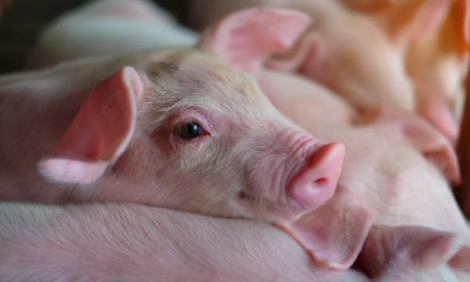



European Project for RFID UHF Animal Ear Tagging of Pigs
A European-wide project ‘Pig Affairs’ is aiming to trace and track every individual animal from birth to the slaughterhouse with its individual information - personal identification number, birth, vaccination etc - stored on a chip.The chip is embedded into standard animal tags available on the market. The read distance, using a 2W reader, is two to three metres using an animal ear tag size of 25 to 27mm.
An enabled Radio-Frequency IDentification (RFID) UHF animal tag is a technology, in which a passive UHF Inlay is embedded (not visible) into a standard animal tag, produced at temperatures of up to 220°C and uses the latest IC Technology from the company Impinj - Monza4D chip.
The UHF animal tag functions without line of sight and has the robustness of standard animal tags.
The large-scale European RFID UHF pilot project, with a prominent European animal ear tagging manufacturer, is being supported by pureSpekt from Freiburg, Germany.
The animal ear tagging manufacturer (who wishes to stay anonymous at this stage) is producing RFID UHF-enabled ear tags for the animal production industry.
UHF inlays specifically designed for livestock ear tags, are being supplied by pureSpekt and embedded into the standard animal tags available on the market.
Introduction

It is estimated that the global human has crossed the seven-billion mark (1) and that by 2030, two Earths (2) will be required to sustain the human being. At the moment, we are using 50 per cent (3) more of its resources than the Earth can provide, according to Charlie Purer of pureSpekt.
With a large population that requires feeding, large food resources need to be available, which generally can only be produced through industrialised (meat) production / intensive livestock farming.
Intensive livestock farming, however, has also been linked to human ill health, hence all the more to ensure traceability and transparency within the food chain.
Animal traceability is not a new phenomenon, after the mad cow disease (BSE) outbreak in the mid-1990s, the European Union continued to endorse new regulations (based on Council Directive 92/102/EEC) for the identification and tracing of cattle, pigs, goats, and sheep - with the objective of installing a platform for food security in Europe.
The latest regulation being in 2004(4), which states that goats and sheep are required to be identified electronically using Low Frequency (LF) technology (Table 1).
Table 1.
| EC Regulation 21/2004 Electronic identification (eID) | International Standards Organization (ISO) Radio Frequency Identification (RFID) regulations |
| Goats & Sheep | ISO 11784 (Code structure) ISO 11785 (transponder activation & data transfer) |
Source - Purser
The general advantages of using eID technology is that animals can be automatically identified (by the animals unique eID number) without handling the animal.
At the moment, EU regulations do not cover all animals for eID tagging. However as mentioned above, it is the objective of the European Commission for Health and Consumers(5) on animal and health strategy to have all livestock that enters the food chain electronically tagged.
The benefits are manifold:
- enhance consumer protection
- improve disease prevention
- control and crisis management
- strengthen the present tracing and tracking system
- reduce administrative tasks
- reduce paper tasks
- reduction of labor costs
- brand protection
- proactive rather than reactive system
What is RFID?
RFID is contactless technology, which uses air interface (electromagnetic waves) to communicate with the environment. In the graphic below, the object is a pig that has an RFID ear tag attached to its ear on which information has been stored.

Source - Purser

Several common frequencies (e.g. LF, HF, UHF) are used worldwide, and depending on the application, the appropriate frequency is chosen.
This is because LF, HF or UHF has its own strengths and weaknesses. Table 2 is an overview of available frequencies, standards
Generally, the standard technology used for livestock identification and managements systems is LF – 134 kHz.
However, the livestock industry is beginning to focus on UHF technology for animal tagging solutions, due its advantages in comparison to LF 134 kHz (Table 3).
Frequency and Standards
Table 2
- 100 kHz 125-135 kHz 10MHz 13,56 MHz 100MHz 860-960MHz 1GHz 2,45GHz 10GHz
World Wide Standards (International Organization for Standardization ISO)ISO 11784 ISO 15693 ISO 18000-6C/Gen2
ISO 17845 ISO 14443
ISO 18000-2 ISO 18000-3
| Frequency Range | Low Frequency (LF) (125-135 kHz) |
High Frequency (HF) (13,56 MHz) |
Ultra High Frequency (UHF) (860-960 MHz) |
Microwave (2,45 GHz) |
| Read Range | < 70 cm | <1 m | <8 m | <10 m |
| Application | e.g. Animal Tagging | e.g. Libraries | e.g. Logistics | e.g. Toll Collection |
| Multi Tag Reads (Bulk) | slow | fast | ||
| Ability to read in harsh environments (metal or wet surfaces | good | challenge | ||
| Tag/Inlay size | big | small | ||
| Investment | high | low |
UHF & LF Technology
Table 3
|
Low Frequency (LF) |
Ultra High Frequency (UHF) |
Ultra High Frequency (UHF) |
|
| Frequency | 125-134,2 Khz | 850-950 MHz | |
| ISO Standards | 11784 / 11785 | EPCglobal & ISO 18000-6C | |
| Memory Size | < 64 bit (not ISO) | < 512 bit | • |
| Coupling | Magnetic | Electromagnetic | • |
| Distortion | ok - Fluids | can be attenuated - Fluids | |
| Read Rate | < 10/second | < 300/second | • |
| - Read (R) - Write (W) - Overwrite (O) - Unique Identification (UID) |
R/O, R/W | R/O, UID, R/W | • |
| Multi-Tag Read (bulk reading) |
No | Yes | • |
| Read Distance | < 70 cm (mobile Readers 20-30 cm) | < 8 m (mobile Readers with 1W out put power - 3-5 m) | • |
| Costs | Tag < 2,00 € depending on volume | Tag < 0,60 € depending on volume | • |
Source - Purser
UHF Animal Tagging Projects
 Within the last 18 months, over 130,000 UHF Tags have and continue to be used in pig tagging projects conducted throughout Europe.
Within the last 18 months, over 130,000 UHF Tags have and continue to be used in pig tagging projects conducted throughout Europe.
A very positive factor is the high volume of pig farms that are participating in pilot projects; that way, testing continues to be conducted under various field conditions involving the tagging of animals from a few weeks old until slaughter. The production sites vary in holding, workflow and environment.
The European ear tag manufacturer mentioned in this article has embarked on a large scale roll out using Europe as its playing field to test its innovative UHF ear-tagging technology.
To date it can be stated, that the read rate of UHF ear tags have exceeded expectations (close to 100 per cent read rate) with a read distance of two metres (approximately 6.5 feet - using 2W readers), in comparison to LF with a read distance of just 20 to 30cm.
Variables that have been, and are under further investigation, are for example the pigs’ ear, where best to position the ear tag to achieve the best read, or how damaged or dirty a UHF tag can be, before it ceases to function. Bulk reading (reading groups of pigs in various numbers – in ms) is also an important element, which caused no concern either in the pigsty or in transit.
The RFID solution consists of UHF stationary (circular polarized) and mobile readers, UHF ear tags and software for data collection.
To summarize; development, production and tests are focused (and are still being carried out) on:
- Quality
- Robustness and size of UHF ear tags
- Read rate and read distance
- Loss of ear tags and tag damage
- Chip functionality in harsh environments (e.g. dirt, moisture, ammonia)
as well as closed and open loop systems i.e. tracing and tracking swine within one location, or various locations within the pigs life cycle in the meat producing eco system.
At this moment and time, test results are still being collated and updated on a daily basis (a summary is expected in Q3), however what can be stated is that farms in the very near future will have access to affordable electronic UHF tagging systems that surpasses LF technology through speed, less administration, clean data, accuracy, brand building, investment and consumer satisfaction.
With UHF technology famers will be able to focus on running their operation with less administrative tasks, a clear overview of their animals history and a reliable tracing and tracking system.
How will the meat production industry, retailer and consumer benefit from RFID?
It was not until December 2000, that through a directive (2000/15/EG) of the European Parliament, it was made law for EU countries to have central registry databases for porcine. The law was passed, to improve disease - management i.e. to prevent disease from spreading and swift eradication of infections.
The process of registering information starts as soon as a change occurs with the present swine holder e.g. farmer, live stock carrier, livestock trader and slaughterhouse.
Minimum Information (some countries register additional information to the minimum requirements by EU legislation) that needs to be registered from each party:
- the companies registration number and address
- type and category of company (e.g. farm, trader, carrier)
- name of responsible person for the animals and address details
- the amount of pigs taken over and date from the previous owner
- the registration number of the company the pigs were taken over from
- every year on the 1st January number of pigs in holding
The system put in place by the EU parliament is an excellent framework to continue developing on. At the moment traceability of swine is generally limited to pig holdings (not in all countries).
However with quality standards rising, the fear of contaminated food, production efficiency (CO2) and resources management, consumers and commerce wish to be informed in far more detail on the product which is being purchased than the consumer 10 years ago.
A further point to consider, are the complex international intertwining global agricultural networks, and trade partners having to fulfill and implement by European law, food safety obligations and conditions.
The advantages to have an automated tracing and tracking system in place, that identifies the individual animal broken down into its constituent parts, are numerous:
The meat production and retail industry will for e.g. have improved visibility, real-time data, improved stock management, facilitate product recalls in the event of a contaminated batch, brand protection, quality improvements, customer satisfaction, customer loyalty, consumer protection and improved crisis management.
The consumer will enjoy peace of mind, stay in good health and be a recurring customer!
References
- http://www.census.gov/population/popclockworld.html
- http://wwf.panda.org/about_our_earth/all_publications/living_planet_report/2012_lpr/
- http://ec.europa.eu/food/animal/identification/ovine/index_en.htm
- http://ec.europa.eu/food/animal/diseases/strategy/pillars/action_en.htm
December 2013








